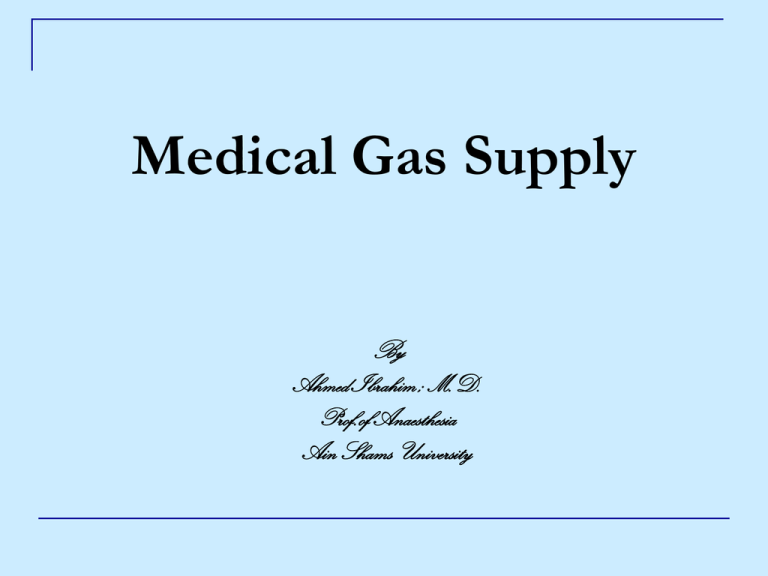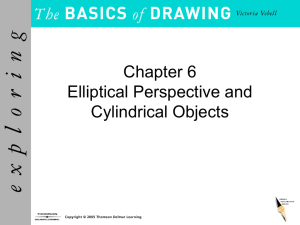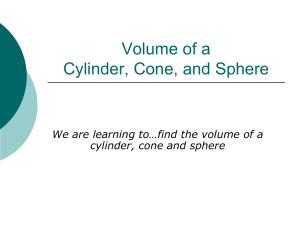Medical gas supply 2013
advertisement

Medical Gas Supply By Ahmed Ibrahim ; M.D. Prof.of Anaesthesia Ain Shams University The gas laws ● Gas exists in the gaseous state at room temperature and pressure. ● Vapour is the gaseous state of a substance below its critical temperature. At room temperature and atmospheric pressure, the substance is liquid. ● Critical temperature is the temperature above which a gas cannot be liquefied whatever pressure is applied. The critical temperatures for nitrous oxide and oxygen are 36.5 and -118°C respectively Gases found on anaesthesia machines •Oxygen •Nitrous oxide •Helium used : -to reduce work of breathing in patients with an upper or lower airway obstruction as it has a lower density than oxygen, nitrogen and air. -in laser surgery around the airway to reduce the flammability of the breathing mixture. -in the measurement of lung volumes because of its very low solubility. •Air used to dilute oxygen when other gases are not desired. Medical Gas Supply cylinders a piped gas system Cylinders ● made of thin-walled molybdenum steel to withstand high pressures. Lightweight O2 cylinders can be made from aluminum alloy used during transport. ● are made in different sizes (A to J).; size E is used on anaesthetic machine; size J is used in cylinder banks. ● O2 cylinders contain gas , while N2O cylinders contain a mixture of liquid and vapour. filling ratio = weight of fluid in cylinder / weight of water required to fill the cylinder filling ratio of N2O is 0.75. In hotter climates, it is reduced to 0.67 ● are colour-coded. Body colour (UK) Shoulder colour (UK) (at room temperature) Pressure, kPa Physical state in cylinder Oxygen Black (Green in USA) White 13 700 Gas Nitrous oxide Blue Blue 4 400 liquid / vapour Carbon dioxide Grey Grey 5 000 liquid / vapour Air Grey (Yellow in USA) White/black quarters 13 700 Gas Entonox Blue White/blue quarters 13 700 Gas Oxygen/helium (Heliox) Black White/brown quarters 13 700 Gas Standard colour Oxygen White Nitrous oxide Light blue Medical air Black and white Suction Yellow Nitrogen Black Carbon dioxide Grey Helium Brown Size Capacity (liters) Oxygen Nitrous oxide E 680 1800 J 6800 18000 absolute pressure = gauge pressure + atmospheric pressure “At a constant temperature, the pressure in a GAS cylinder decreases linearly and proportionally as it empties. “ This is not true in cylinder containing liquid / vapour. Cylinders are tested regular intervals, usually 5 years: 1. Internal endoscopic examination 2. Flattening , bend and impact tests ; are carried out on at least 1/100 cylinders. 3. Pressure test ; the cylinder is subjected to high pressures of about 22 000 kPa, which is more than 50% above their normal working pressure. 4. Tensile test ; where strips of the cylinder are cut and stretched. This test is carried out on at least 1/100 cylinders. Marks engraved on the cylinders are: 1. Test pressure. 2. Dates of test performed. 3. Chemical formula of the cylinder’s content. 4. Tare weight (weight of nitrous oxide cylinder when empty). Labeling. The cylinder label includes the following details: ● name, chemical symbol, pharmaceutical form, specification of the product, its license number and the proportion of the constituent gases in a gas mixture ● substance identification number and batch number ● hazard warnings and safety instructions ● cylinder size code ● nominal cylinder contents (litres) ● maximum cylinder pressure (bars) ● filling date and expiry date ● directions for use ● storage and handling precautions. Cylinder valves ● They are mounted on the neck of the cylinder. ● Act as an on/off device for the discharge of cylinder contents. ● Pin index system to make it almost impossible to connect a cylinder to the wrong yoke ( O2 2&5 , N2O 3&5 , CO2 1&6 , Air 1&5 ) Index positions of a cylinder valve O2 N2O CO2 2,5 3,5 1,6 ● Bodock sealing washer must be placed between the valve and the yoke of the anaesthetic machine. Pressure Regulator As gas flows out of the low-pressure chamber, the drop in pressure reduces the force generated by the diaphragm (D) against the spring (S), allowing the valve (V) to open and admit gas from the high-pressure chamber. The output pressure may be adjusted by a screw (A) that alters the force applied by the spring. Piped Gas Supply ● a network of copper alloy pipelines from central supply points. ● The outlets are colour- and shape-coded to accept matching ‘Schrader’ probes. wall-mounted outlet socket ceiling unit ● Flexible and colour-coded pipelines run from the anaesthetic machine to the outlets. ● There is risk of fire from worn and damaged hoses. Source of Gas supply ● Cylinder manifold: banks of large cylinders( usually size J), usually divided into two groups, primary and secondary (alternating supplying the pipelines automatically) ● Liquid oxygen: a thermally insulated vessel at a temperature of -150°C to -170°C and a pressure of 5 –10 atmospheres is used. ● Oxygen concentrator: extracts oxygen from air by differential absorption, a zeolite molecular sieve is used. Cylinder Manifold Liquid Oxygen atmospheric air is entrained by the concentrator, filtered and raised to a pressure of 20 psi by a compressor THANK YOU









